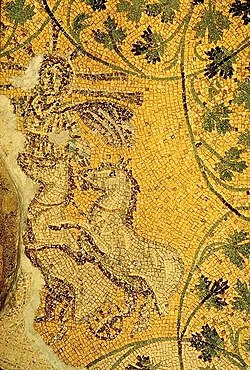Tomb of the Julii
| Tomb of the Julii | |
|---|---|
 Detail of the mosaic | |
 Click on the map for a fullscreen view | |
| General information | |
| Location | Vatican City |
| Coordinates | 41°54′8″N12°27′12″E/ 41.90222°N 12.45333°E |
The popularly named "Tomb of the Julii"(Mausoleum" M ") survives in theVatican NecropolisbeneathSt. Peter's Basilica.The serendipitous discovery near thecrypthas a vaulted ceiling bearing amosaicdepicting Apollo as Jesus Christ with anaureoleriding in his chariot, within a framing of rinceaux of vine leaves. The mosaic is dated to the late 3rd century to early 4th century. Other mosaics in this tomb depicting Jonah and the whale, the good shepherd carrying a lamb (thekriophorosmotif), and fishermen have encouraged its interpretation as a Christian tomb.
This tomb was first discovered in 1574 AD when workmen accidentally broke through the ceiling while conducting some floor alterations in the basilica. The inside was briefly explored and documented before the opening was sealed over once more.[1]
See also
[edit]References
[edit]- Beckwith, John 1979.Early Christian and Byzantine Art(Yale University Press): 19
- Perler, Othmar 1953,Die Mosaiken der Juliergruft im Vatikan(Universitätsverlag): 34–36
- Walsh, John Evangelist.The Bones of Saint Peter(The Chaucer Press): 15
- Specific
- ^The Bones of Saint Peter, John Evangelist Walsh 1982
Further reading
[edit]- Weitzmann, Kurt,ed.,Age of spirituality: late antique and early Christian art, third to seventh century,no. 467, 1979,Metropolitan Museum of Art,New York,ISBN9780870991790
